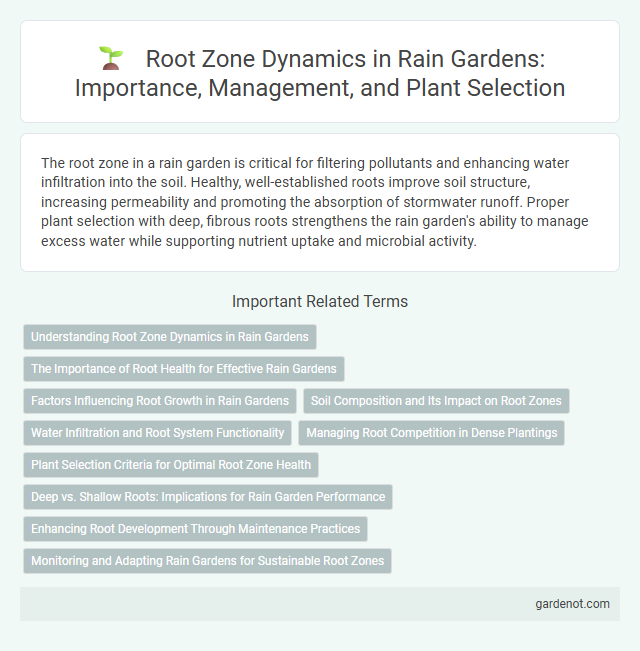The root zone in a rain garden is critical for filtering pollutants and enhancing water infiltration into the soil. Healthy, well-established roots improve soil structure, increasing permeability and promoting the absorption of stormwater runoff. Proper plant selection with deep, fibrous roots strengthens the rain garden's ability to manage excess water while supporting nutrient uptake and microbial activity.
Understanding Root Zone Dynamics in Rain Gardens
Understanding root zone dynamics in rain gardens is essential for enhancing water absorption and pollutant filtration. The root zone, typically extending 12 to 18 inches deep, supports diverse native vegetation that promotes microbial activity and soil aeration, critical for nutrient cycling and stormwater management. Optimizing soil composition and moisture levels within this zone maximizes the rain garden's efficiency in mitigating runoff and improving urban water quality.
The Importance of Root Health for Effective Rain Gardens
Healthy root zones are essential for rain gardens to efficiently absorb and filter stormwater, preventing runoff and reducing pollutants. Robust root systems enhance soil structure, increase water infiltration, and support beneficial microbial activity that breaks down contaminants. Maintaining root health ensures long-term functionality and resilience of rain gardens in urban water management.
Factors Influencing Root Growth in Rain Gardens
Root growth in rain gardens is influenced by soil composition, moisture levels, and aeration within the root zone. Optimal loamy soils that balance drainage and nutrient retention promote extensive root development, while excessive compaction or waterlogging restricts oxygen availability and stunts growth. Temperature fluctuations and the presence of mycorrhizal fungi also play critical roles in enhancing root absorption efficiency and overall plant health.
Soil Composition and Its Impact on Root Zones
Soil composition significantly influences the root zone development in rain gardens by affecting water retention, aeration, and nutrient availability essential for plant growth. A balanced mix of sand, silt, clay, and organic matter promotes optimal drainage while supporting root oxygenation and microbial activity, crucial for pollutant removal through biofiltration. Well-structured soils with moderate permeability enhance root expansion and improve the rain garden's overall efficiency in stormwater management and groundwater recharge.
Water Infiltration and Root System Functionality
The root zone in a rain garden plays a critical role in enhancing water infiltration by breaking up compacted soil, allowing rainwater to percolate efficiently into the ground. A healthy root system increases soil porosity and supports microbial activity, which improves nutrient cycling and overall soil structure. Deep, fibrous roots stabilize the rain garden substrate while facilitating the uptake and filtration of stormwater pollutants, ensuring effective water management and ecosystem functionality.
Managing Root Competition in Dense Plantings
Effective management of root competition in dense rain garden plantings requires selecting species with complementary root structures and growth rates. Incorporating deep-rooted plants alongside shallow-rooted ones maximizes water absorption and nutrient uptake while reducing interspecies competition. Regular monitoring and strategic root pruning promote healthy development, ensuring optimal ecosystem function and stormwater management.
Plant Selection Criteria for Optimal Root Zone Health
Selecting plants for a rain garden requires focusing on root systems that tolerate fluctuating moisture levels and promote soil aeration in the root zone. Deep-rooted native species such as switchgrass (Panicum virgatum) and blue flag iris (Iris versicolor) enhance water infiltration and nutrient uptake, optimizing the root zone environment. Ensuring a diversity of root structures supports microbial activity and prevents soil compaction, leading to sustainable rain garden performance.
Deep vs. Shallow Roots: Implications for Rain Garden Performance
Deep roots in rain gardens enhance soil infiltration and stability by penetrating compacted layers and promoting water percolation, while shallow roots primarily support surface soil structure and plant anchorage. Rain gardens with a combination of deep-rooted native plants, such as switchgrass (Panicum virgatum), and shallow-rooted species optimize pollutant removal and reduce surface runoff. The interaction between root depth and soil composition directly influences rain garden efficiency in stormwater management and groundwater recharge.
Enhancing Root Development Through Maintenance Practices
Maintaining optimal moisture levels and regularly removing compacted soil significantly enhances root zone aeration, promoting healthy root development in rain gardens. Incorporating organic mulch reduces evaporation, stabilizes soil temperature, and supports beneficial microbial activity essential for robust root growth. Periodic inspection and strategic pruning of plant roots prevent overcrowding, ensuring efficient nutrient uptake and long-term sustainability of the rain garden ecosystem.
Monitoring and Adapting Rain Gardens for Sustainable Root Zones
Monitoring soil moisture, nutrient levels, and root health is essential for maintaining sustainable root zones in rain gardens. Adaptive management techniques, such as adjusting irrigation and selecting drought-tolerant plant species, enhance root resilience and water infiltration. Consistent evaluation ensures optimal root development, promoting long-term stormwater filtration and ecosystem benefits.
Root zone Infographic

 gardenot.com
gardenot.com